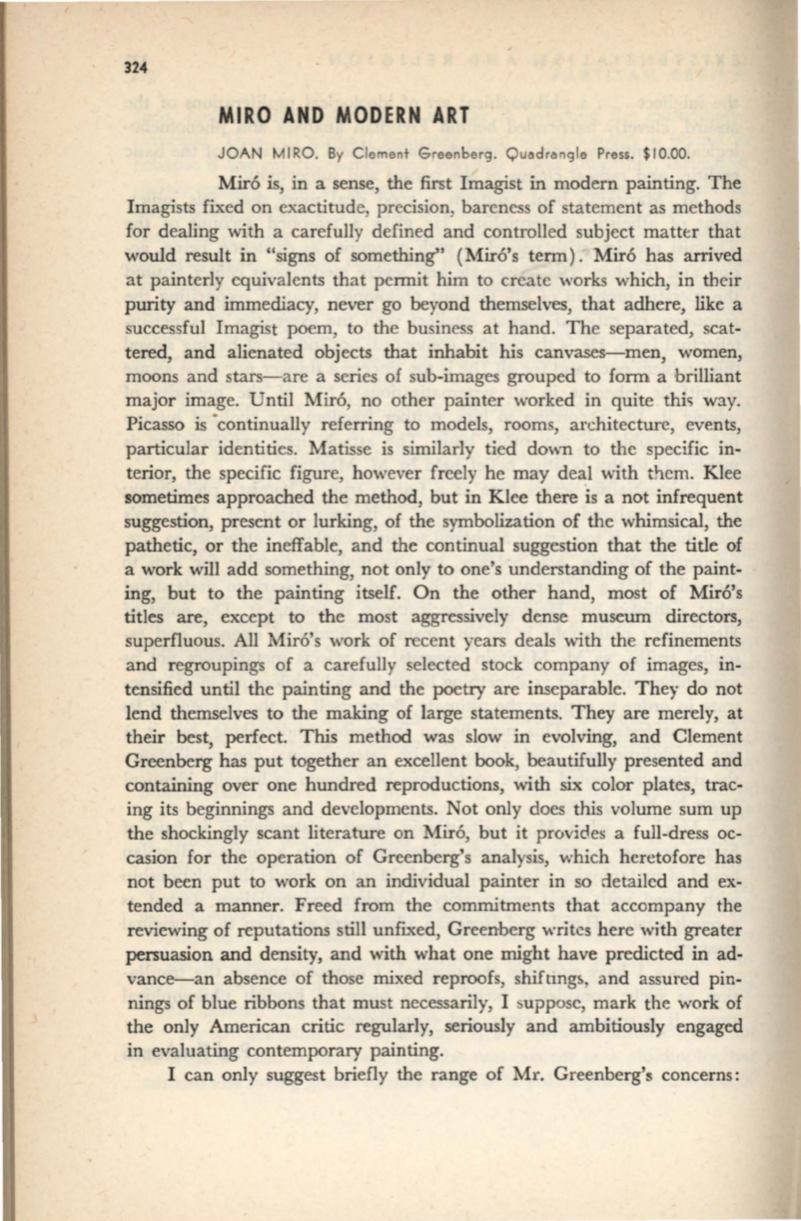
324
MIRO AND MODERN ART
JOAN M IRO. By
Clement Greenberg. Quodrongle Press.
$10.00.
Mir6 is, in a sense, the first Imagist in modern painting. The
Imagists fixed on exactitude, precision, bareness of statement as methods
for dealing with a carefully defined and controlled subject matter that
would result in "signs of something" (Mir6's term). Mir6 has arrived
at painterly equivalents that permit him to create works which, in their
purity and immediacy, never go beyond themselves, that adhere, like a
successful Imagist poem, to the business at hand. The separated, scat–
tered, and alienated objects that inhabit his canvases-men, women,
moons and stars-are a series of sub-images grouped to form a brilliant
major image. Until Mir6, no other painter worked in quite this way.
Picasso is 'continually referring to models, rooms, architecture, events,
particular identities. Matisse is similarly tied down to the specific in–
terior, the specific figure, however freely he may deal with them. Klee
sometimes approached the method, but in Klee there is a not infrequent
suggestion, present or lurking, of the symbolization of the whimsical, the
pathetic, or the ineffable, and the continual suggestion that the title of
a work will add something, not only to one's understanding of the paint–
ing, but to the painting itself. On the other hand, most of Mir6's
titles are, except to the most aggressively dense museum directors,
superfluous. All Mir6's work of recent years deals with the refinements
and regroupings of a carefully selected stock company of images, in–
tensified until the painting and the poetry are inseparable. They do not
lend themselves to the making of large statements. They are merely, at
their best, perfect. This method was slow in evolving, and Clement
Greenberg has put together an excellent book, beautifully presented and
containing over one hundred reproductions, with six color plates, trac–
ing its beginnings and developments. Not only does this volume sum up
the shockingly scant literature on Mir6, but it provides a full-dress oc–
casion for the operation of Greenberg's analysis, which heretofore has
not been put to work on an individual painter in so detailed and ex–
tended a manner. Freed from the commitments that accompany the
reviewing of reputations still unfixed, Greenberg writes here with greater
persuasion and density, and with what one might have predicted in ad–
vance-an absence of those mixed reproofs, shiftmg&, and assured pin–
nings of blue ribbons that must necessarily, I suppose, mark the work of
the only American critic regularly, seriously and ambitiously engaged
in evaluating contemporary painting.
I can only suggest briefly the range of Mr. Greenberg's concerns:


